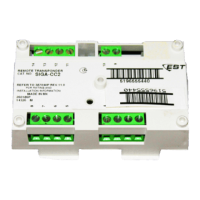(1) Signal polarity is shown when the circuit is in supervisory state.
Polarity reverses when the circuit is active.
(2) Supervised.
(3) Power-limited unless connected to a nonpower-limited source. If
the source is nonpower-limited, eliminate the power-limited mark
and maintain a minimum of 0.25 in. (6.4 mm) space from power-
limited wiring. For other mounting methods, see enclosure and
bracket installation sheets to maintain separation of power-
limited and nonpower-limited wiring. The wire size must be
capable of handling fault current from nonpower-limited source.
— or —
Use type FPL, FPLR, FPLP, or permitted substitute cables,
provided these power-limited cable conductors extending beyond
the jacket are separated by a minimum of 0.25 in. (6.4 mm)
space or by a nonconductive sleeve or nonconductive barrier
from all other conductors. Refer to the NFPA 70 National
Electrical Code for more details.
(4) If using a G1-P Genesis series horn while connected to a
compatible fire alarm control panel, a CDR-3 Bell Coder must
be used to comply with NFPA 72 standard alarm evacuation
signal.
(5) 47 kΩ EOLR (P/N EOL-47).
(6) Signaling line circuit (SLC) to next device.
(7) Channel 1 (ALERT) AUX riser to next module or riser
supervisory device.
(8) Power-limited regulated, power supply UL/ULC Listed for fire
protective signaling systems.
(9) Channel 1 (ALERT) AUX riser from previous device.
(10) Signaling line circuit (SLC) from previous device. Supervised
and power-limited.
(11) Channel 2 (EVAC) AUX riser from previous device.
(12) Channel 2 (EVAC) AUX riser to next module or riser
supervisory device.

